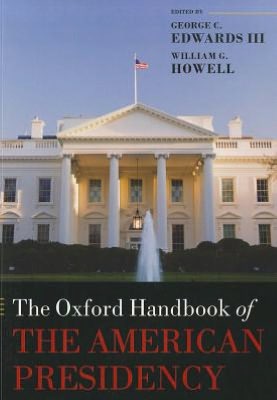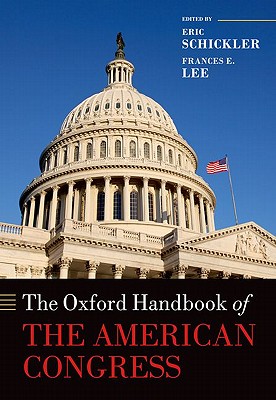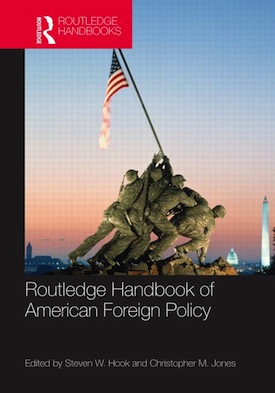The organisation of American political life, and the various organs of government in the US can often seem impenetrable. The three handbooks featured here provide an accessible route into US politics and foreign policy.
The idea that the President of the USA – commonly referred to as the most powerful person in the world – actually shares power with other branches of government is perhaps mystifying. Even more mystifying when one learns that the relative power of the various organs of government oscillate rather than remain a constant. For example, during the first five years of the Nixon administration, Richard Nixon reigned in what has been widely referred to as an imperial presidency. In doing so, he progressively shut the US congress out of power. Yet, twenty years later the congress shut down the entire US government in a budget dispute with Bill Clinton, rendering him temporarily unable to govern. Understanding the vast array of interest groups who influence US politics through lobbying, political financing and media manipulation adds another layer of intrigue to any student attempting to grapple with US politics.
 There are a range of single volumes (such as this one) that introduce students to the intricacies of American government. However, the utility of such books quickly passes as you advance in your studies. The Oxford Handbook of the American Presidency (AP) and the Oxford Handbook of the American Congress (AC) are two edited collections that any student of US politics would be well served to consult. Both are extremely heavyweight and ultra current in their analysis, and represent more of an expansive edited collection of journal-quality articles written by experts, than a textbook written to reduce a particular subject into a bite sized package. NB: both books are part of Oxford Scholarship Online, so you may find that your institution has a subscription.
There are a range of single volumes (such as this one) that introduce students to the intricacies of American government. However, the utility of such books quickly passes as you advance in your studies. The Oxford Handbook of the American Presidency (AP) and the Oxford Handbook of the American Congress (AC) are two edited collections that any student of US politics would be well served to consult. Both are extremely heavyweight and ultra current in their analysis, and represent more of an expansive edited collection of journal-quality articles written by experts, than a textbook written to reduce a particular subject into a bite sized package. NB: both books are part of Oxford Scholarship Online, so you may find that your institution has a subscription.
AP rightly asserts that the presidency absorbs more attention in scholarship than other organs of government. Yet, the book takes no issue with this and reaffirms through almost 900 pages just why the presidency is worthy of so much attention. On the other hand, AC looks at the major opponent of the president in US politics, the Congress. The bulk of AC is domestic in its orientation. This is no surprise as foreign policy is generally carried out by the executive, with congress playing an advise and consent role alongside exercising its budgetary powers. However, beyond the domestic orientation of AC, readers will find valuable chapters (particularly chapters 34 and 35) relating to the crossroads between Capitol Hill and the White House on foreign policy issues.
AC is an impressive volume, which delivers a broad palette of congressional analysis written by notable experts. Yet, I was slightly disappointed in my foreign policy-focused tendencies to only find one chapter that dealt in volume with congressional war powers, and one chapter that dealt substantively with lobbying. It seems that the Oxford University Press powers that be have deemed it necessary to have a separate handbook on the latter – which may explain its short order serving here. Yet, that being said, those who have a need to consult a catch-all volume on the domestic political role of the congress (which is substantial), will do well to keep AC in mind.
The strength of AP is in its unbroken focus and attention to detail. In that sense it is more useful to students of international politics than AC. If you want to learn about how a new president transitions from a victorious candidate, to establishing a political agenda, and then to implementing that policy agenda – AP delivers time and time again. What the book does not do is examine why or how certain candidates came to office. For that, you will need to look elsewhere.
new president transitions from a victorious candidate, to establishing a political agenda, and then to implementing that policy agenda – AP delivers time and time again. What the book does not do is examine why or how certain candidates came to office. For that, you will need to look elsewhere.
Several large sections of AP deal directly with the use of presidential power in foreign policy. Alongside chapters on war and international cooperation stand three lengthy chapters on the effectiveness of presidential unilateral action. Presidents are (arguably) entitled to exercise unilateral power constitutionally through executive orders, proclamations, elite agreements with foreign leaders, National Security Directives, and so on. For some, the idea that the most powerful person in the world should have to resort to bargaining with the congress and other organs of governance in something as important as high stakes diplomacy is an anathema. Hence, the attractiveness of harnessing unilateral action has been a recurring feature of US politics. Each of the three aforementioned chapters unpack this issue, using frequent examples from various administrations and time periods.
The only slight drawback to AP is that its authors are overwhelmingly US-centric, if not American themselves. This ensures that the book has a very US-flavoured political science overlay. This is not a weakness for a politics student per se, nor does it reduce the utility of the book. But, it may give the impression that the study of the presidency does not need to be analysed or reflected upon by any other tools other than various US-centric political science methodologies.
 Coming fully into foreign policy focus, the Routledge Handbook of American Foreign Policy (AFP) is a brand new entrant into the market. Whilst still only available in hardback, and thus prohibitively expensive, it will make a highly desirable purchase for undergraduate students once it is released in paperback. In opposition to AP and AC, the editors of AFP seem to have understood the idea of a handbook not being heavier than a small coffee table! At 450 pages, it is a concise, but effective volume. AFP’s structure is excellently planned out. It flows logically, and it reads excellently.
Coming fully into foreign policy focus, the Routledge Handbook of American Foreign Policy (AFP) is a brand new entrant into the market. Whilst still only available in hardback, and thus prohibitively expensive, it will make a highly desirable purchase for undergraduate students once it is released in paperback. In opposition to AP and AC, the editors of AFP seem to have understood the idea of a handbook not being heavier than a small coffee table! At 450 pages, it is a concise, but effective volume. AFP’s structure is excellently planned out. It flows logically, and it reads excellently.
Like AP and AC, each chapter is written by a different author. And, again like AP and AC, the authors are overwhelmingly US-centric. Yet, in the case of AFP, it avoids the trap that AP falls into (noted above) by incorporating a very wide palette of views and methodologies. This incorporates chapters on diplomatic history, realism, liberalism, critical theories and constructivism. This is AFP’s first winning formula. By placing these chapters in the first two sections of the book, the editors have ensured that the reader is immediately served a broad gamut of viewpoints and approaches.
A second winning formula in AFP appears in the middle section of the book, which comprises 8 separate chapters on the range of US state actors who dominate and influence foreign policy making. The chapters are not exhaustive, but they each fulfil their purpose of situating and explaining the relative influence of one particular organ of foreign policy governance – such as the State Department, the National Security Council, the Congress, the Pentagon (and so on). Subsequently, the influence of non-state actors is also incorporated through chapters on public opinion, the media, and interest groups.
The final 2 sections of AFP make for more selective reading – and are more stand alone than the first two thirds of the book. Through chapters on trade, sanctions, aid, arms, use of force, terrorism, environmental politics, and human rights – the book adds a plethora of ultra-current political issues for the reader to consult. Obviously, there is much that could have been added to this list of topics by the editors. Yet, the selection provides a decent range of issues that the reader can use to explore and apply the various methodological and theoretical angles explored earlier in the book. In that sense, while the final third of the book is less impressive than the first two thirds, it is a valuable trigger to further reading.
Further Reading on E-International Relations
- New Book – Global Politics in a Post-Truth Age
- Student Feature – Theory in Action: Liberalism and American Imperialism
- New Book – Policy and Politics of the Syrian Refugee Crisis in Eastern Mediterranean States
- Student Essay Award – Win Free Books and Get Published
- New Book – Varieties of European Subsidiarity: A Multidisciplinary Approach
- New Book – Dignity in Movement: Borders, Bodies and Rights